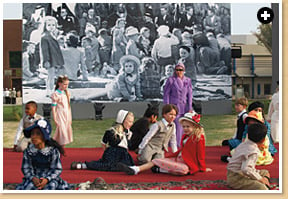
Written by Arthur Clark
 |
| ARTHUR CLARK |
| Saudi Aramco schoolchildren, dressed and posed to resemble the youngsters shown with King ’Abd al-’Aziz in 1947, were part of the company’s 75th-anniversary celebration in May. Below: Kathryn Kennedy Dewey, nine when she met King ’Al al-’Aziz in 1947, returned to Dhahran in 2008 to meet King Abdullah. To her, being “treated so honorably” during the six-day stay in Dhahran was a valued expression of the respect Saudi Aramco and Saudi Arabia feel for the work her parents did to help launch the kingdom’s oil industry. “The honoring of our parents was truly overwhelming,” she said. |
 |
| AHMED AL-DUBAIS |
wo days, separated by 61 years, stand layered in one photograph, bookending the past and the present at Saudi Aramco: Two days during which ordinary Americans lined up to meet two kings of Saudi Arabia.
The first day was January 25, 1947. King ‘Abd al-‘Aziz Al Sa‘ud, Saudi Arabia’s founding monarch, visited the post–World War II boomtown of Dhahran, on his kingdom’s east coast, to meet the children and wives of the oilmen who had recently begun to tap the country’s petroleum wealth in earnest.
The second day was May 20 of this year, 2008. King Abdullah, ‘Abd al-‘Aziz’s son and Saudi Arabia’s sixth monarch, visited Dhahran to meet 29 of the same “1947 Kids,” some now accompanied by spouses or grown children, to express his thanks for their parents’ help in Aramco’s early days, two generations ago.
The event was part of the company’s celebration of the 75th anniversary of the day in 1933 when King ‘Abd al-‘Aziz’s finance minister signed the agreement that kicked off oil exploration in Saudi Arabia. For the returning 1947 Kids, the generation-spanning reception opened a layer cake of memories.
“I thought King ‘Abd al-‘Aziz was quite scary: He was a big man with a beard and a drooping eyelid,” recalled David Lunde, who was just five years old in 1947. But, he said, there was a bowl of Fig Newtons next to the king, and “I thought that anyone who liked Fig Newtons as much as I did must be a good guy.” The king’s hand “seemed huge when I shook it, and it was callused and hard. But he spoke very gently and smiled. I really liked him. That’s one of the few hard memories I have of that time.”
Lunde was among those who returned for the May 20 ceremony, held at almost exactly the same spot in Dhahran as the 1947 event. This time, however, the meeting was in the evening, after sunset—and after an earlier ceremony in which the king had laid the cornerstone of a new cultural center to be built in his father’s name. There were spotlights and film crews, dancing troupes of youngsters and adults, and even children acting out the roles of the 1947 Kids— all to cap Saudi Aramco’s 75th-anniversary festivities.
The audience, too, was much larger than it had been in 1947, but the king appeared to enjoy greeting each of the visitors, much as his father had. Lunde recalled that King ‘Abd al-‘Aziz “was saying a lot and patting people on the head,” and that King Abdullah too “was really into the whole thing.”
Other 1947 Kids had similar feelings about ‘Abd al-‘Aziz.
“I felt kind of mesmerized because he was such a big man,” recalled Mary Kennedy Brooks, who was 12 in 1947. “I had been reading The Arabian Nights, and I equated him with that. I thought he was a magnificent character. He took my hand, and his was so large he just enveloped it … and he just smiled.”
With the passage of 61 years, she found King Abdullah “not so overwhelming as his father,” Brooks noted. All the same, it was an emotional event for someone who’d lived in Saudi Arabia both as a girl and then later as the wife of an Aramco employee before finally departing 30 years ago. “I started crying when I began to say ‘thank you,’” Brooks said.
Two days earlier, Saudi Aramco president and CEO Abdallah Jum‘ah had emphasized the company’s enduring ties to its US employees at a dinner in honor of the 1947 Kids and their families. “We appreciate what you have done, what your fathers—possibly your grandfathers —have done, and we will keep that appreciation with us forever,” he said. “The success of Saudi Aramco is basically its American connection, its heritage. The American tradition, the American background, is our own, and we built on it.”
 |
Arthur Clark worked for Aramco and Saudi Aramco as a writer and editor for 21 years, and also wrote nearly 50 articles for this magazine, contributing photographs for many of them. He is now editor of Al-Ayyam al-Jamilah and assistant editor of Saudi Aramco World. |